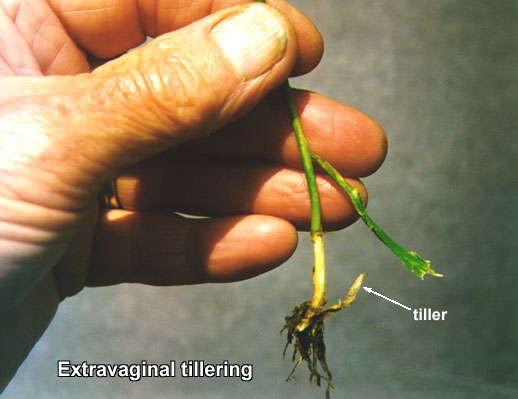Sod-forming grasses are characterized by their capacity to produce either rhizomes or stolons, each being a modified stem, which extends laterally enabling the grass to develop a firm sod. Rhizomes are underground stems, varying widely in length, often extending 12 inches or more before the tip breaks through the soil crust to form a new shoot. Stolons remain largely at the soil surface with new shoots and roots arising from nodes.
Both rhizomes and stolons arise from adventitious buds in crown tissue. However, adventitious buds may also give rise to a new shoot with viturally no lateral spreading. In either case, the new growth breaks through the surrounding leaf sheath to form an independent branch of the mother stem. This type of branching is called extravaginal growth.
Since their growth is often horizontal, their growing points are often low to the ground and avoid removal by defoliation. Sod-forming grasses will fill in spots and form a tight web of plants.
Most grass species classified as bunchgrasses do not produce well developed rhizomes or stolons and therefore have a tufted growth habit as opposed to dense sod. The adventitious buds of bunchgrasses are found on the basal nodes in crown tissue and produce new tillers which remain within the surrounding leaf sheath of the mother stem. This type of branching is called intravaginal and the plants maintain an erect growth habit. This feature results in a bunch or tussock type of growth with minimal lateral spreading as occurs with rhizomes and/or stolons. The upward growth means that their growing points are often susceptible to removal by defoliation.
Grasses which reproduce vegetatively from adventitious buds on corms represent still another class. Corms are thickened, bulbous internodes which form in crown tissue, serving as storage organs. New tillers arise from nodes in the corms.
The following list designates the sod-forming or bunchgrass growth habit of the common forage grasses.

